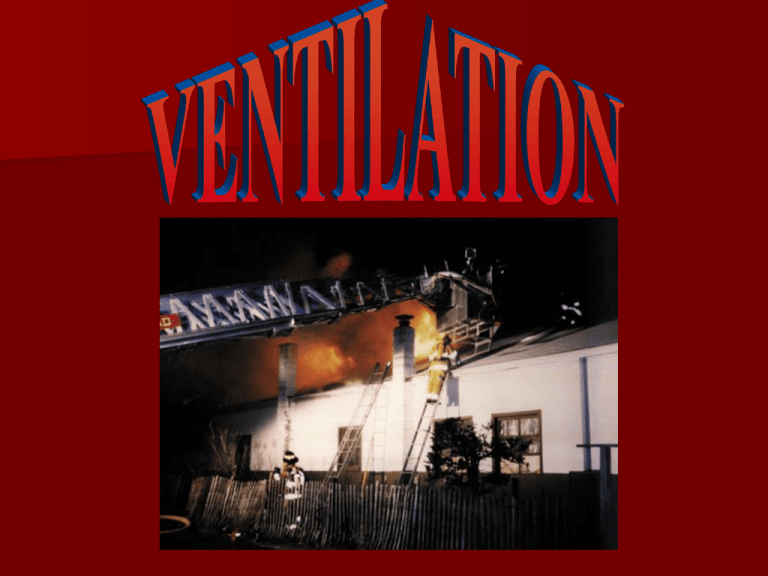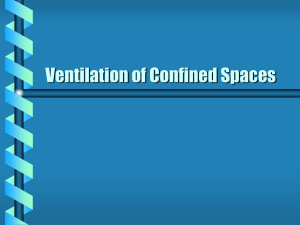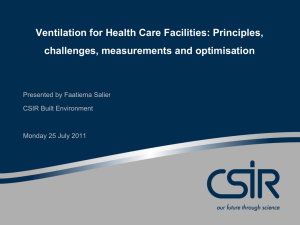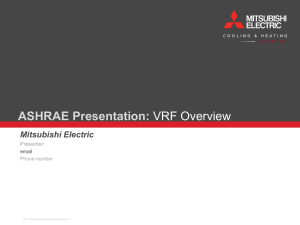No Slide Title
advertisement

Objectives 1 of 3 Understand ventilation as a fire service tool. Know the principles, advantages, and effects of ventilation. Know the origins and effects of heat, smoke, and toxic gases. Differentiate between flashover, backdraft, and rollover. Objectives 3 of 3 Identify safety considerations when venting operations are in progress. Identify the factors affecting ventilation. Describe ventilation techniques. Identify the types of ventilation. Identify the mechanics of ventilation. Introduction Ventilation is the planned and systematic removal of pressure, heat, gases, and smoke. Ventilation is a very complex subject area with many factors. Ventilation is a part of the coordinated fire attack. Ventilation will be in place before fire attack!! Principles, Advantages, and Effect of Ventilation 1 of 3 Ventilation is the relief of the products of combustion from an enclosed area. This is a very essential part of fire suppression effort. This prevents fire from heating up other parts of the structure. Principles, Advantages, and Effect of Ventilation 2 of 3 As heat is exhausted and dissipated its ability to spread the fire is reduced Ventilation channels smoke out of the structure. As smoke builds up vision is obscured. Heavy smoke conditions can obscure light completely. Principles, Advantages, and Effect of Ventilation 3 of 3 Unburned hydrocarbons irritate eyes. Smokes contain many deadly substances. Removal of smoke will add survival time to a victim, increasing the chance of successful rescue. Heat, Smoke, and Toxic Gases When fire burns, air heats, expands, becomes lighter, and rises. Heated air spreads by convection and radiation. Fire gases consists of many deadly products of combustion. Newer approach to construction makes ventilation even more important. Considerations for Proper Ventilation 1 of 3 Important to understand behavior of fire gases. Smoke rises and mushrooms. Vertical ventilation is the removal of gases and smoke through vertical channels. Horizontal ventilation is channel smoke through horizontal openings. Without ventilation, heat, smoke and steam have no where to go. Path of Travel for Smoke Considerations for Proper Ventilation 2 of 3 An opening is needed for smoke and byproducts to exit as attack team moves in. Ventilation can be as critical as applying water. Many factors must be considered when venting. Considerations for Proper Ventilation 3 of 3 A size up of the structure is very important. Height of building will also have an impact. Wind can alter ventilation. Bad weather affects smoke’s ability to travel. Through proper ventilation the fire’s ability to extend can be removed. Fire and Its By-Products During combustion energy is released. Molecules reunite to form new substances. These substances can be caustic to humans. Ventilation will remove some substances. Ventilation has many other benefits. Flashover, backdraft, and rollover can occur without ventilation. Fire Phenomena Flashover. Backdraft (smoke explosion). Rollover. Flashover Light, smoke, and heat are liberated as part of the combustion process. Everything in a confined area ignites at almost the same time. It is important to know the mechanics of a flashover to understand its development. Backdraft (Smoke Explosion) 1 of 2 A rapid ignition of smoke. Incomplete combustion occurs as oxygen levels decrease. As fire consumes greater amounts of oxygen, the production of CO increases. With the heat, pressure builds in the confined space. Backdraft (Smoke Explosion) 2 of 2 When an opening occurs, a billow of smoke escapes. Cooler air causes air to contract. Mixture increases CO concentration. Once CO concentration reaches the flame, components are primed for ignition. Signs of Potential Backdraft Smoke-stained windows. Puffing of smoke at seams and cracks. Smoke pushing out under pressure. No visible flames. Heavy black smoke. Tightly sealed building. Large, open area or void. Extreme heat. Rollover Heated products of combustion rise to higher levels. Heated gases reach their ignition and begin to spread across the room along the ceiling. When the upper thermal layer is disrupted, the heat is forced down. Expanding Heat and Steam What Needs to be Vented? Without ventilation expanding heated steam and smoke will roll over. Small voids and compartments need to exhaust increasing pressure. Areas such as cockloft need to be checked. Horizontal and vertical voids. Areas to Vent Mechanics of Ventilation Ventilation is simply the movement of air from high pressure to lower pressure. Knowing the natural tendency of air movement is important. Improvement of air conditions is crucial. Horizontal and vertical ventilation conform to the same rules. Mechanics of Ventilation SYSTEMATIC removal of products of combustion. Ventilation controlled fire. Ventilation controlled fire Ventilation Techniques Break glass. Ax. Open doors. Portable ladder. Rope and a tool. Aerial ladder tip. Hook or pike pole. Negative pressure. Iron or Halligan. Positive pressure. Types of Ventilation Ventilation can occur using several methods: – Natural. – Mechanical: HVAC. Smoke fans. Positive pressure. Hydraulic. Objectives: – Describe all safety concerns with vertical ventilation – Describe advantages and disadvantages of vertical ventilation – Describe common procedures for vertical ventilation – Demonstrate ability to determine roof integrity – Identify proper tools used during vertical ventilation Vertical Ventilation This next section will cover Vertical Ventilation, both on Residential and Commercial Buildings We will cover the basics on how to ventilate these types of buildings There are several types of material that is used for the roof decking We will start out with the Residential Roofs Vertical Ventilation Residential Roofs These types of roofs can be either flat or pitched The procedure is fairly simple Whether the roof is pitched or not, the procedure is the same Vertical Ventilation Tools – Cutting Pick head or flat head axe K12 Circular Saw (All Engine Companies) Chain Saw (T82) – Stripping Pike Pole Rubbish Hook (T82) Existing Roof Openings – Scuttle Hatches Commercial Occupancies – Skylights Residential and Commercial – Air Handlers Residential and Commercial – Exhaust Vents Commercial – Attic Vents Safety Concerns – – – – One of the most dangerous jobs on the fire scene Use of power tools Visibility Smoke/Heat Full PPE – Access/Egress Multiple points – Roof Integrity SOUND IT!!, SOUND IT!!, SOUND IT!! –Accessing the Roof Minimum on 2 access/egress points –Place on different walls of building Ground or Aerial Ladders –Aerial Placement Interior roof access –Scuttles Size Up the Roof – Construction type and features Ridge Line/Truss Direction Weight Bearing Walls Lightweight Construction Age of Building/Roof Loads on Roofs Drop Offs – Existing Openings Skylights, Scuttles, etc Size Up – Roof Covering Tile vs. Shingles Torch Down Metal Synthetic Foam Membrane – Signs of Integrity Sagging Roof lines – Vents growing Fire Smoke Venting Getting on the Roof – Sound the Roof Before you step on the roof Strike the roof with a tool (axe, rubbish hook) Feel and sound solid Regularly sound the path you choose and stick to the sounded path. Scan the roof continuously Working on the Roof – NEVER cross roof diagonally – Walk on ridges, trusses, outside walls – Work from roof ladders if possible – Work from aerials if possible – Consider safety hoseline (controversial) Open the Roof – BE SAFE ALWAYS – Never cut in line with your body or that of your partner – Work in teams of two minimum – One person cuts, the other backs him up – If you fall and begin to slide, flatten out and your partner will jump on you Open the Roof – Inspection Holes Helps find direction of trusses Triangle in shape 1-2 foot per side ALWAYS work on the WINDWARD – (Wind at your back) Don’t get caught down wind – that is where the fire is going Louver Opening – Fast and Efficient = less time on roof – Must know direction of trusses/rafters – NEVER stand on the hole you are cutting – Always work back to your egress Vertical Ventilation The goal is to get a hole at least 4’ x 8’ It can be cut in line with the trusses or perpendicular to the trusses If the cut is made perpendicular to the trusses, you have to cross at least three trusses. Three on the top and three on the bottom If the cut is made in line with the trusses, you will only have to cross the truss once at the top and one at the bottom Louver Opening 1st Cut Mark Trusses 2nd Cut 3rd Cut 4th Cut Last Cut After the hole is cut – Open the ceiling – Contact Command – GET OFF THE ROOF!! Trench Opening – Typically used in commercial – Long, narrow opening – Assist in stopping the fire spread – Long time to accomplish = long time on roof – Can also be louvered VERTICAL VENTILATION Trench Opening Hoseline Trench Opening – Defensive cut. – Q-deck / rolled roof. – Considered outdated by some tactic and strategy subject matter experts. Summary – – – – – BE SAFE Size up the roof Sound the roof Make your hole Get OFF!!! Fire Walls Hose line Hydraulic Ventilation Negative Pressure Ventilation Smoke Ejector Structural Ventilation Safety Considerations Will ventilation permit the fire to extend? Will the escape route be cut off? Will ventilation endanger others? Are firefighters working in teams? Is there proper supervision? Obstacles to Ventilation Access. Security devices. Height. Poor planning. Unfamiliar building layout. Ventilation timing. Cut a roof/open a roof. Factors Affecting Ventilation Partial openings. Partially broken windows. Screens. Roof materials Dropped or hanging ceilings. Building size. Weather. Opening windows. AN ANALYSIS OF POSITIVE PRESSURE VENTILATION HushCompartment #4 QuantumCompartment #5 POSITIVE PRESSURE VENTILATION TODAYS FIRES PRODUCE 20,OOO BTU’s PER POUND COMPARED TO 8,000 BTU’s 10 TO 15 YEARS AGO. USE OF PLASTICS AND MODERN CONSTRUCTION MATERIALS POSITIVE PRESSURE VENTILATION INCREASED CO AND TOXIC GASES NEW TECHNOLOGY IN PROTECTIVE EQUIPMENT. TYPE V CONSTRUCTION- LIGHT WEIGHT ADVANTAGES ADVANTAGES OVER NATURAL VENTILATION ARE OBVIOUS PPV VS. NEGATIVE PRESSURE – PERSONNEL ARE NOT EXPOSED TO INTERIOR ATMOSPHERES – FIRE GASES ARE NOT EXPOSED TO BLOWERS ADVANTAGES - BLOWERS RUN MORE EFFICIENTLY - INTERIOR DOORWAYS AND HALLS ARE UNOBSTRUCTED - NO NEED FOR DROP CORDS OR “Z” BARS - LESS NOISE AND CONFUSION - REDUCED AIR AGGITATION INSIDE STRUCTURE ADVANTAGES - SUPERIOR IN SPEED AND EFFICIENCY - TWICE AS EFFICIENT IN REMOVING CONTAMINATES - HEAT AND SMOKE DIRECTED AWAY FROM EXITS OR UNBURNED AREAS ADVANTAGES MORE EFFICIENT IN ROOMS WITH VAULTED CEILINGS EQUALLY EFFECTIVE WITH HORIZONTAL OR VERTICAL VENTILATION HAS MINIMAL EFFECTS ON SMOLDERING DEBRIS- IFSTA CHAPEL HILL STUDY 1300 SQ. FT. SINGLE FAMILY DWELLING NATURAL VENTILATION- CO LEVELS OVER 600 PPM IN 3.5 MINUTES AFTER IGNITION. REMAINED AT OVER 100 PPM FOR 20 MIN. DESPITE VENTILATION EFFORTS CHAPEL HILL STUDY PPV PRIOR TO FIRE ATTACK. 400 PPM IN 3.5 MIN. 0PPM IN 16 MIN. PPV AFTER FIRE ATTACK 600PPM IN 5 MIN. 0PPM AFTER 16 MIN. CHAPEL HILL STUDY DECREASE IN SMOKE CONDITIONS AND OTHER TOXIC GASES-CYANIDE REDUCED TOXICITY FOR VICTIMS EASIER FOR FIREFIGHTERS TO LOCATE VICTIMS 50% OF RESIDENTIAL DEATHS DUE TO CO INTOXICATION CHAPEL HILL STUDY MOST RESIDENTIAL FIREFIGHTER DEATHS ARE DUE TO DISORIENTATION AND EXHAUSTING AIR SUPPLIES IF USED IN HORIZONTAL APPLICATIONSREDUCED COLLAPSE GUILFORD COLLEGE STUDY TWO STORY 1800 SQ. FT. SINGLE FAMILY DWELLING PPV PRIOR TO WATER PPV AFTER WATER ATTEMPT TO MOVE FIRE WITH PPV GUILFORD COLLEGE STUDY INCREASED VISIBILITY AND REDUCED HEAT INITIALLY AND TEMPORARILY INCREASES HEAT IN THE BURN ROOM PPV PLACED BEFORE WATER IS MORE EFFECTIVE IN HEAT REMOVAL IN AREAS DIRECTLY EFFECTED BY THE FIRE GUILFORD COLLEGE STUDY “ AT NO TIME WAS FIRE VISUALLY SEEN BEING PUSHED THROUGHOUT THE STRUCTURE EVEN WITH AN EXHAUST PORT OPENING IN THE INCORRECT PLACE, OR INCORRECT SIZE.” U.S. COAST GUARD STUDY FIREFIGHTER SKIN TEMP. PRIOR TO EVOLUTION WITHOUT PPV WAS 90.8 DEGREES- 100.3 AFTER SKIN TEMP. 94.8 WITH USE OF PPV HISTORY INTRODUCED BY THE LOS ANGELES CITY FIRE DEPARTMENT OVER THIRTY YEARS AGO VERY CONTROVERSIAL USUALLY DUE TO DEPARTMENTS THAT ARE NON-RECEPTIVE TO CHANGE IMPLEMENTATION SOP’s MUST BE USED TO PREVENT TRAGIC CONSEQUENCES PERSONNEL MUST BE WELL TRAINED ON MECHANICS AS WELL AS THEORY IMPLEMENTATION THOROUGH SURVEY EXHAUST OPENING BETWEEN ¾ TO 1 AND ¾ THE SIZE OF THE OPENING EXHAUST OPENING AWAY FROM POTENTIAL VICTIMS PLACE FAN ON UNINVOLVED SIDE OF THE STRUCTURE - 9,000 TO 15,000 CFM MINIMUM IMPLEMENTATION IF POSSIBLE, USE PPV ON THE WINDWARD SIDE OF STRUCTURE ENTER STRUCTURE 15 SECONDS AFTER IMPLEMENTATION IMPLEMENTATION PULL CEILING IMMEDIATELY AFTER ENTERING STRUCTURE OPEN LINE OF COMMUNICATIONS PROBLEMS WITH PPV ARE USUALLY ASSOCIATED WITH LACK OF TRAINING OR DISREGUARD OF THE CONCEPT IMPLEMENTATION NOT RECOMMENDED FOR CURTAIN WALL OR BALLOON TYPE CONSTRUCTION GIVES AN INITIAL INCREASE OF OXYGEN TO FIRE CREWS MUST BE ABLE TO READ SMOKE CONDITIONS KNOW YOUR EQUIPMENT BEDROOM 2 BEDROOM 1 GARAGE KITCHEN ROOM FAMILY ROOM BEDROOM 3 DINING BATHROOM BEDROOM BEDROOM 2 3 DINING ROOM KITCHEN FAMILY ROOM BEDROOM 1 GARAGE BATH BEDROOM BEDROOM 2 3 DINING ROOM KITCHEN FAMILY ROOM BEDROOM 1 GARAGE BATH OTHER APPLICATIONS DUMPSTER OR CAR FIRES OVERHAUL Ventilation nightmare SUMMARY ESTABLISHED A NEED TO VENTILATE PPV REDUCES CO AND OTHER TOXIC GAS LEVELS IMPROVES FIREFIGHTER SAFETY BY INCREASING VISIBILITY SAFER AND FASTER THAN VERTICAL VENTILATION SUMMARY MORE EFFECTIVE THAN NEGATIVE PRESSURE VENTILATION REDUCES FIREFIGHTER BODY TEMPERATURES LESS TIME ON TASK EFFECTIVE WHEN CLEAR UNDERSTANDING OF CONCEPT AND MECHANICS SOP Review Vertical Ventilation Residential Roofs These types of roofs can be either flat or pitched The procedure is fairly simple Whether the roof is pitched or not, the procedure is the same









